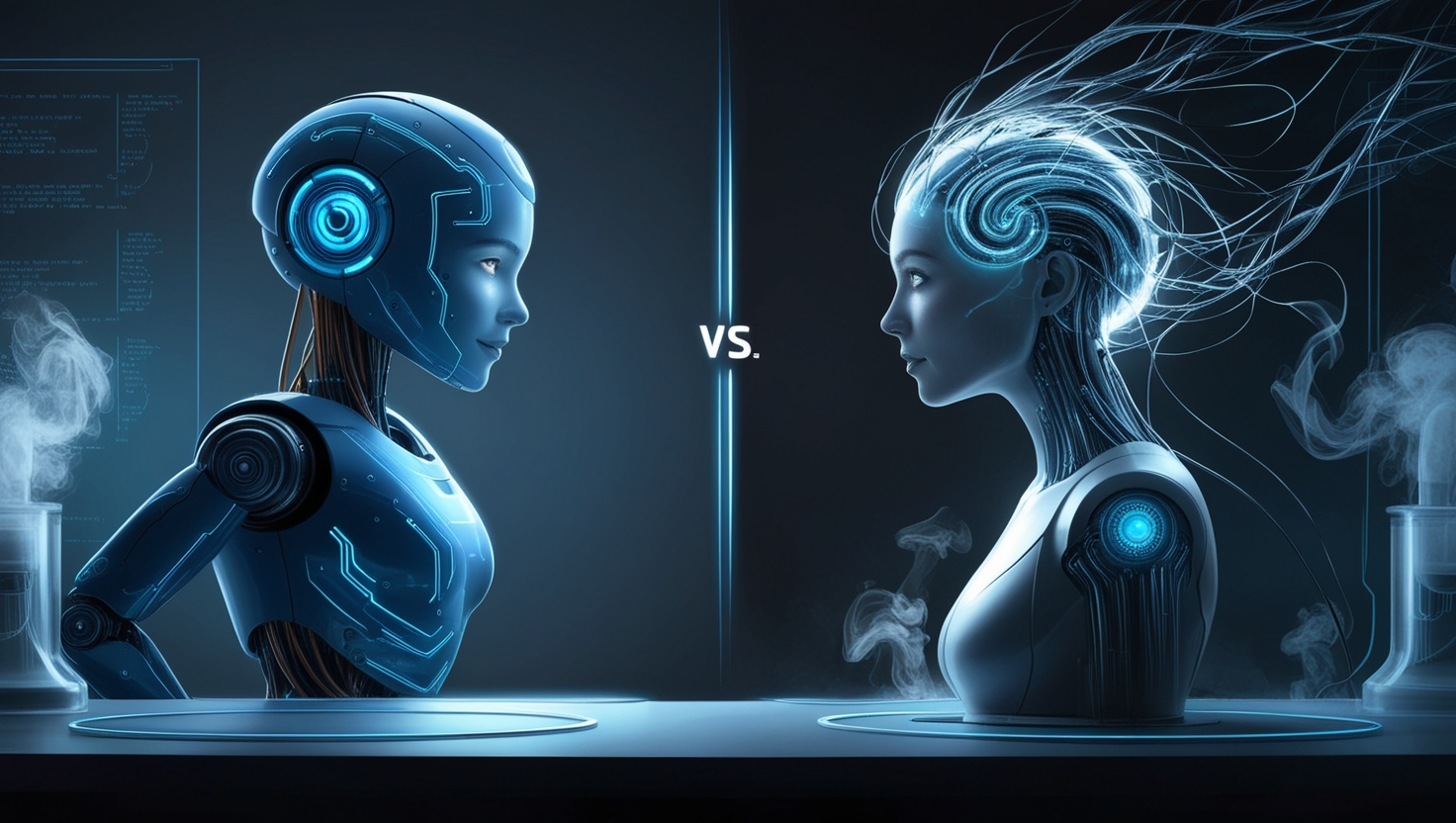The Age of AI Delegation: How Leaders Are Learning to Let Go
A practical guide for leaders to distinguish which decisions AI can handle and which require human judgment.

Introduction
In today’s business landscape, the phrase “delegate and trust” takes on a new and profound meaning. We’re no longer just talking about handing tasks to team members — we’re talking about delegating decision-making authority to artificial intelligence (AI) agents. This represents a fundamental shift for leaders across sectors, especially in SMEs (small and medium-sized enterprises) and growth-stage companies. The question is no longer simply whether to automate, but when, what, and how to allow AI to make decisions — and crucially, when not to.
The promise is compelling: faster decisions, data-driven insights, 24/7 availability, scalability without proportional head-count increases. Yet at the same time, there are very real risks: over-reliance, loss of human judgement, ethical concerns, and erosion of accountability. In this blog post we’ll explore the new frontier of AI delegation, why it matters for leaders, how to decide what to delegate — and what must remain under human oversight.
Why AI Delegation Matters Now
There are several overlapping trends that make this topic urgent:
- Explosion of data and complexity. Many organisations now face such a volume and velocity of data that no single human or even team can absorb the full picture in real-time. AI systems can process, summarise and infer patterns at scale. For example, recent research shows that AI-enabled decision-making leads to significant efficiency gains in multi-criteria decision contexts. (SSRN)
- Rise of intelligent agents. The maturation of machine learning, natural language processing, and predictive analytics means that AI is no longer limited to “assistive” roles. It’s becoming capable of recommendation, action, and, in some cases, autonomous decisioning. For leaders this opens the possibility of handing off decisions typically reserved for humans.
- Competitive pressure and speed. In a globalised market — especially for firms operating across Europe, the USA and North America (as Matriks does) — speed and agility increasingly differentiate winners and laggards. AI agents can provide faster scenario modelling, quicker risk assessment and improve responsiveness.
- Leadership capacity and cognitive load. Leaders are juggling more than ever: strategy, culture, technology, regulatory changes, talent shortages, and more. Delegating routine or analytical decisions to AI frees up capacity for leaders to focus on uniquely human work (vision, ethics, culture, relationships).
Given these drivers, it’s no wonder that many senior teams are asking: Which decisions can and should go to AI? And further: What do we absolutely need to keep human?
What “Delegation” Means in an AI Context
When we talk about AI delegation, we’re referring to the process by which a human leader or a managerial system assigns decision-making responsibility — either wholly or partially — to an AI system, and accepts its output as binding (or sufficiently authoritative) without requiring full human re-validation for every instance.
Here are a few nuanced forms of delegation:
- AI as decision-support: AI generates recommendations or insights; humans retain final authority.
- AI as decision-agent: AI makes decisions with limited human review or oversight; humans intervene only if triggered.
- AI as autonomous decision-maker: AI makes decisions and executes them automatically, with humans only monitoring outcomes.
The spectrum matters. Full autonomy may make sense for low-risk, high-volume decisions (for example, routing invoices or responding to standard queries). But high-stakes strategic, ethical or ambiguous decisions still demand human involvement.
Research underlines this: in a study of decision-delegation to AI in surrogate vs non-surrogate contexts, willingness to hand over responsibility varied significantly. (ScienceDirect) Another paper on human–AI collaboration shows that performance and satisfaction improved when AI delegated tasks to humans or vice-versa — but the design and context matter. (arXiv)
Thus, the act of “letting go” is not a blind leap; it’s a calibrated shift that involves trust, governance and calibration of boundaries.
Why Leaders Are Hesitant — and What the Barriers Are
For many leaders, the notion of handing over decision rights to machines triggers several valid concerns:
- Accountability and Responsibility
If an AI makes a decision that turns out poorly, who is accountable? The leader? The AI vendor? The algorithm’s designer? Without clear governance, delegation risks becoming abdication. A recent review argues that leadership must act as a mediator between human intelligence and AI systems, providing ethical oversight and maintaining human agency. (PMC) - Loss of Intuition and Human Judgment
Some decisions are driven less by data and more by tacit knowledge, gut instinct, nuance of context or stakeholder relationships. Over-delegating risks losing that human edge. - Bias, Fairness and Transparency
AI systems inherit biases in data, design and usage. Delegated decisions lacking transparency can undermine trust, lead to regulatory trouble, or damage brand reputation. In SMEs and larger firms alike, frameworks emphasise the need for autonomy, justice, explicability and beneficence in AI deployment. (MDPI) - Cultural Resistance and Change Management
Teams and stakeholders may mistrust decisions that seem to come from “the machine”, or feel de-skilled if humans are sidelined. Leaders must manage change in mindset as well as process. - Over-automation and “letting go too soon”
Delegation is not about spinning the wheel faster; when done poorly, it can lead to brittle systems that fail in novel cases. A recent article noted how over-delegation (in a non-AI context) slowed decision-making, reduced risk-taking and undermined organisational effectiveness. (Business Insider)
Mapping Which Decisions Can Be Delegated (And Which Are Better Kept Human)
One of the practical challenges for leaders in the age of AI delegation is determining which decisions can safely be handed over to AI systems and which should remain under human control. This distinction is not always obvious, but it becomes clearer when viewed through several key dimensions.
The first dimension is volume and frequency. Decisions that occur frequently and follow a standardised pattern—such as approving invoices, routing requests, or handling first-line customer queries—are excellent candidates for delegation. These repetitive tasks benefit from automation’s speed and consistency. In contrast, one-off, novel, or highly uncertain decisions should remain human-led, as they require creativity, contextual understanding, and flexible judgment.
Next is rules and predictability. If the decision follows clear, well-defined rules or can be modelled accurately with reliable data—for instance, setting supply chain reorder levels—it can often be safely managed by AI. However, decisions that involve ambiguity, moral nuance, or subjective judgment are best handled by humans, as they rely on interpretation and ethical reasoning rather than formulaic logic.
A third dimension is impact and risk. When decisions carry low to medium risk—where errors are easily reversible and oversight mechanisms exist—AI can efficiently take charge. Yet for high-stakes decisions, such as mergers and acquisitions, regulatory or legal commitments, or actions affecting brand reputation, human intervention is non-negotiable. These scenarios demand accountability, foresight, and sensitivity that machines cannot replicate.
The data or logic-driven nature of a decision also matters. AI excels when it can draw upon abundant, high-quality data with clear historical patterns. But when decisions hinge on “soft” factors—like relationships, company culture, brand perception, or leadership vision—human discernment is irreplaceable.
Another consideration is speed and real-time demand. In environments where rapid responses are crucial—like dynamic pricing, logistics routing, or real-time alerts—AI is well-suited to make immediate, data-driven choices. Conversely, strategic decisions that benefit from reflection, negotiation, or stakeholder input should remain in human hands.
Finally, the accountability and ethics dimension underscores the need for balance. AI can be entrusted with tasks that operate within transparent, well-defined ethical and legal frameworks, as long as humans retain final oversight. But where the ethical implications are complex or accountability must be human-centric—such as decisions affecting people’s welfare, fairness, or rights—leaders must retain direct control.
In essence, effective AI delegation isn’t about removing humans from decision-making—it’s about deciding when human judgment adds irreplaceable value. Leaders who understand these dimensions can build systems that combine the precision of machines with the wisdom of people.
Using such a matrix helps leaders map out an “AI delegation frontier” — i.e., the boundary between machine-handled decisions and human-retained decisions. It’s not binary — many decisions will fall into a hybrid zone where AI provides the data-driven insight, and humans provide the oversight and final judgement.
Framework for Safe, Effective AI Delegation
Here’s a step-by-step framework for leaders at SMEs or growth companies (like Matriks) to safely implement AI delegation:
- Define the decision-set
- Map out all decision types across the organisation (operational, tactical, strategic).
- Classify them by the typology above: volume, predictability, risk, data-intensity.
- Identify candidates for delegation and those to keep human.
- Map out all decision types across the organisation (operational, tactical, strategic).
- Establish governance & human-in-the-loop design
- Define clear ownership: Who is ultimately accountable if the AI decision is wrong?
- Ensure transparency: AI outputs must be explainable (to humans and stakeholders).
- Set boundaries: Define which decisions AI handles entirely, which ones humans will review.
- Maintain oversight: Set human checkpoints, exception flags, and escalation paths.
- Define clear ownership: Who is ultimately accountable if the AI decision is wrong?
- Train the AI and calibrate trust
- Use historical data to train models, but also test extensively under realistic ‘edge-cases’.
- Run AI and human side-by-side (shadow mode) for a period to validate performance and build trust.
- Monitor metrics of performance, satisfaction, error-rates.
- Use historical data to train models, but also test extensively under realistic ‘edge-cases’.
- Change management and skill-building
- Prepare teams: Training, communication, mindset shift from “AI as threat” to “AI as collaborator”.
- Redefine roles: Staff will need to transition from doing tasks to supervising AI, interpreting results, managing exceptions.
- Build culture of continuous learning: Both human teams and AI systems will evolve.
- Prepare teams: Training, communication, mindset shift from “AI as threat” to “AI as collaborator”.
- Ethics, fairness and regulatory compliance
- Ensure model design takes account of fairness, bias, data privacy, transparency. Research shows this is especially important in SMEs. (MDPI)
- Ensure compliance with regulations (e.g., in Europe, the forthcoming EU AI Act).
- Embed regular audits of AI-decisions (who overrides, when, why, with what outcomes).
- Ensure model design takes account of fairness, bias, data privacy, transparency. Research shows this is especially important in SMEs. (MDPI)
- Monitor performance and refine
- KPIs: decision time, accuracy/error-rates, cost savings, human oversight burden, user satisfaction.
- Continuously review: Retain the flexibility to move decisions back to human if AI fails or context changes.
- De-delegation: Recognise that delegation isn’t irreversible. If AI outputs degrade (drift) or context shifts, human intervention must re-enter.
- KPIs: decision time, accuracy/error-rates, cost savings, human oversight burden, user satisfaction.
Practical Case Studies and Examples
Example 1 – Operational Delegation: A retail SME uses AI to route customer service queries. For straightforward requests (e.g., “track my order”, “reset password”), the AI agent handles the decision and response automatically. For complex queries (e.g., “claim for damage”, “contract dispute”) the AI flags and escalates to human. The result: faster response times for the majority of cases, lower cost, while humans focus on high-value interactions.
Example 2 – AI in Finance Decision-Making: A company uses predictive analytics to gauge cash-flow risk and uses AI to decide when to alert finance teams about potential shortfalls, and in some instances to trigger an automated re-schedule of supplier payments. The high-volume/medium-risk nature of this decision made it a good candidate for AI delegation. Meanwhile strategic investment decisions remained human-led.
Example 3 – Where delegation went too far: A firm allowed an AI to autonomously decide dynamic discounts for loyal customers without human override, under the assumption it reduced cost. Unfortunately the AI lacked awareness of brand-perception and over-discounted some segments, leading to margin erosion and brand de-valuation. This underscores the importance of boundaries and escalation design.
These examples illustrate that success is not about “simply handing over” to AI, but rather carefully selecting the decision domain, designing the hand-off mechanism, and retaining human judgement where it matters most.
When Not to Delegate: Guardrails & Red Lines
Leaders must recognise that there are decisions which either should not be delegated, or can only be delegated under strict supervision. Here are some categories of red-lines:
- Ethical or moral decisions. Where stakeholder trust, fairness, human dignity, values or brand integrity are at stake.
- Ambiguous or novel contexts. When the business faces a new market, disruptive change, strong uncertainty, or ambiguous signals — human intuition, creativity and experience matter.
- High-impact, irreversible decisions. Mergers, acquisitions, major capital programmes, significant organisational restructuring.
- Identity, culture and leadership decisions. Decisions that shape the company’s culture, values, vision, leadership direction or brand. These are inherently human.
- Regulated or legally binding decisions. If a decision affects regulatory compliance, legal liability, human rights, privacy or safety — human oversight is essential.
- Situations requiring trust, empathy or human relationships. For example, employee-relations issues, key customer negotiation, or leadership of change. AI lacks the full human context, intuition and emotional intelligence.
In short: If a decision requires judgement, purpose, values, narrative, or relationship, then human leadership must remain central.
Leadership Competencies for the AI Delegation Era
Successful leaders in this new era will need to develop or strengthen certain competencies:
- AI Literacy – Understanding the capabilities and limitations of AI systems; being able to engage meaningfully with technical teams, vendors and data scientists.
- Decision Architecture Thinking – Mapping decisions across the organisation, specifying which to delegate, which to retain, understanding data flow, escalation routes, human-in-the-loop design.
- Change & Culture Leadership – Leading the transformation, communicating the “why”, ensuring teams buy in, managing fears of job loss, role change and identity shift.
- Ethical and Strategic Oversight – Ensuring that AI-delegated decisions align with values, brand, stakeholder expectations; establishing governance, monitoring, audit, transparency.
- Human-Machine Collaboration Mindset – Treating AI as a collaborator not a competitor. Redefining roles so humans focus more on what machines cannot easily do (creativity, empathy, judgement, relationships).
- Continuous Learning – Both personal learning (keeping up with AI advances, data ethics) and organisational learning (monitoring outcomes, refining delegation boundaries, adapting as technology evolves).
According to research, leadership now acts as mediator in the human-AI relationship — not simply deciding whether to adopt AI, but how to structure the collaboration between human intelligence (HI) and artificial intelligence (AI). (PMC)
Pitfalls to Avoid (and How to Mitigate Them)
Here are some common mistakes, with suggestions for how to mitigate:
- Mistake: Rushing into full delegation without pilot or human oversight → Mitigation: Begin with low-risk domain, run shadow mode, build trust gradually.
- Mistake: Assuming AI is “set and forget” → Mitigation: Regularly monitor for drift, context change, model degradation; maintain human check-points.
- Mistake: Outsourcing oversight entirely to vendor without internal ownership → Mitigation: Establish clear accountability internally; leadership must remain responsible.
- Mistake: Ignoring team culture / staff fears → Mitigation: Transparent communication, training, role redefinition, emphasise human-machine collaboration.
- Mistake: Treating delegation as cost-cutting rather than value-creation → Mitigation: Frame delegation as freeing up human time for higher-value work (strategy, creativity, relationships).
- Mistake: Over-reliance on AI for human or ethical decisions → Mitigation: Clearly map and retain human judgement where needed; build in ethical oversight frameworks.
Looking Ahead: The Future of Leadership in the AI-Delegation Era
As AI systems become more capable, leaders will increasingly shift from being sole decision-makers to being orchestrators of human-machine systems. Here are some future-facing thoughts:
- Hybrid leadership models will emerge: Leaders who manage teams of humans and AI agents, ensuring alignment, culture, oversight and meaning.
- Decision interfaces will evolve: Instead of leadership sifting through spreadsheets, dashboards will summarise for humans: “Here are 5 decisions the AI recommends; you must review these 2; the other 100 were handled.”
- Trust and transparency become strategic differentiators: Organisations that can demonstrate explainable AI, human-in-loop design and ethical oversight will win stakeholder confidence.
- Organisations become adaptive ecosystems: With modular decision systems, organisations will delegate routine decisions to AI and humans can focus on innovation, culture, purpose, stakeholder relations.
- Governance, regulation and ethics will move front-stage: As delegation becomes more common, regulatory frameworks (such as the EU AI Act) will demand clear accountability for AI-made decisions.
- Redefinition of skills: The most valued leader will not be the one who knows every detail but the one who knows which decisions to delegate, how to design that delegation, when to intervene and why retention of human judgement matters.
Leaders who master this delegation boundary — the ‘what to give to AI, what to keep for humans’ — will unlock disproportionate value: speed, scale, innovation — while preserving human agency, trust and strategy.
Conclusion
We’re entering an era where leaders must learn a different kind of letting go. It is not the relinquishing of responsibility, but rather the wise handing over of certain decision-rights to machines so that humans can focus on what machines cannot do. For organisations like Matriks Ltd, working with SMEs across the UK, US and Europe, this isn’t a distant future — it’s now.
The key is not simply “use more AI” but “delegate intelligently”. Map your decision landscape, recognise which decisions are suitable for AI, design governance and oversight, build culture and capability, and always retain the human where it matters most.
In the age of AI delegation, the best leaders won’t be those who automate everything — they’ll be the ones who make the smartest choices about what to automate, what to keep human, and how to orchestrate the partnership between human and machine.



%20(63).png)